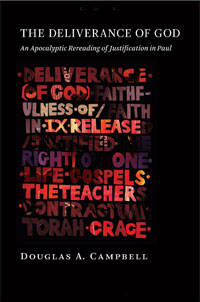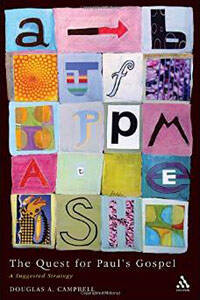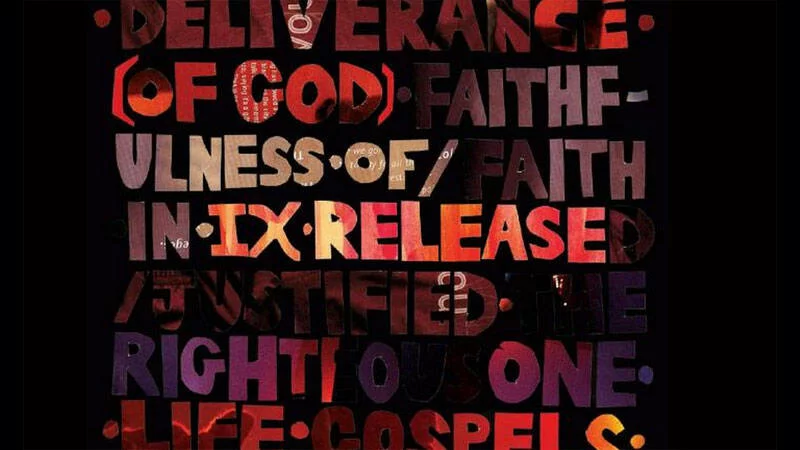I suspect there will be many readers of the previous posts who have found little with which to disagree or criticize, and this is not surprising given that this basic construal of Paul has dominated both church and academy since at least the Protestant Reformation. It is not for nothing, after all, that references to Augustine, Chrysostom, Luther, and Calvin permeate the writings of traditional Pauline scholars like Moo and Westerholm. So where’s the debate? What is there not to like about this interpretation of Paul that has held sway for so long?
To put it as clearly as possible, for Douglas Campbell, the model I have described in the previous two posts, which he refers to as “Justification Theory,” (hereafter JT) is bad theology based on a powerful misreading of Paul’s texts. Such a claim is sure to shock many readers, and with the caveat that it is impossible to do justice to Campbell’s 1200+ page argument in his The Deliverance of God, allow me to set forth three of Campbell’s primary critiques of JT before we look at his alternative proposal in the next post.[1]
Problem #1: A Prospective Orientation
First, Campbell argues that the traditional plight to solution model makes for bad theology due to its prospective orientation—that is precisely due to its movement from plight to solution. But why is this prospective orientation such a problem? Don’t we need to know what the problem is before we can understand how Christ accomplishes our salvation? If one begins by setting up an analysis of the plight of the human, then, for Campbell, Christ’s saving work has already been determined by the first stage of the human plight. To use Campbell’s words, this model “works forward from a particular understanding of the problem to its Christian solution, and hence, just because it works forward, its ‘Christian’ solution is dictated before it arrives by assumptions derived within the problematic pre-Christian state.”[2] What happens with this model, then, is that a version of natural theology is  unwittingly privileged over the Christ-event, such that the individual learns about God, justice, humanity, and Judaism apart from God’s special revelation in Christ. And this is epistemologically problematic for the Christian since according to this model “the critical epistemological criteria of salvation do not belong to the Christ-event, but, rather, to this first phase of the human plight.”[3]
unwittingly privileged over the Christ-event, such that the individual learns about God, justice, humanity, and Judaism apart from God’s special revelation in Christ. And this is epistemologically problematic for the Christian since according to this model “the critical epistemological criteria of salvation do not belong to the Christ-event, but, rather, to this first phase of the human plight.”[3]
The forward-thinking movement of the traditional model results, further, in an unfair and inaccurate treatment of Judaism, for it sets up “Judaism” as the first stage through which the Christian must progress. Judaism functions as something of a generic metaphor, usually without any sympathetic reading of the Second Temple Jewish texts on their own terms, typified in its commitment to works of the law, that corresponds to this first stage.[4] Judaism sets forth obedience to the works of the law as the false path toward righteousness, a path with which humanity must struggle and then come to the realization of its sinfulness before it sees the need for the gospel. But this view of Judaism, for Campbell, is entirely unfair and invariably fails to provide any empirical justification for this view of Judaism.
Problem #2: Contractual Theology
Second, JT’s theology is problematic because of its commitment to contractual theology.[5] Campbell has in mind here the traditional interpretation’s opposition between doing and believing, a contrast focused on alternative human activities that are basically construed according to the logic of a contract. In other words, God stipulates something to the effect of “If you do all the works of the This model’s anthropology is too voluntarist in its emphasis on individual choice or decision to believe.law, then I will justify you; but if you do not do all the works of the law, then I will condemn you.” Since everyone, however, fails to obey the law perfectly, God sets up a second contract that has a more manageable criterion than perfect obedience, namely, faith. Campbell describes this alternative contract: “In this variation those exercising Christian faith can grasp a second, easier, and specifically Christian contract.”[6]
Campbell sees at least two problems with this contractual model. First, this version of contractual theology portrays a God who rules over a law-governed society and punishes violations of his justice or, alternatively, rewards those who fulfill the criterion of faith. Campbell worries that “at the heart of this system is the initial projection of a set of cultural analogies into the key theological roles that then determine all that follows.”[7] In other words, a political Western model—with God as a monarch, reality as law-governed, justice as decidedly fair and retributive—may, again unwittingly, be determinative for how Paul’s texts are being read.
Second, while faith is undoubtedly an easier, more manageable criterion than perfect obedience to the law, it is still the case that people must do something to be saved. Paul’s gospel, then, is conditional and simply makes salvation possible but without accomplishing it. Campbell worries that this model’s anthropology is too voluntarist in its emphasis on the individual making a choice or decision to believe. The gospel is, then, with this model simply an offer or a possibility to be accepted or rejected, rather than a powerful and unconditional gift independent of the human response it elicits.
Problem #3: Participation and Salvation
The final criticism that Campbell lodges at JT is that this soteriological model—characterized by its prospective, contractual, and conditional orientation—cannot be reconciled with Paul’s alternative (and more prevalent!) participatory soteriology.[8] In other words, the traditional reading of Romans 1–4 is at variance with the soteriology found in chapters 5–8. Campbell believes that Romans 5–8 provides a “detailed account of Paul’s entire gospel—a gospel that reaches others where they are, transforms them in Christ, and opens them up to a glorious life of freedom in the Spirit and of communion with the triune God.”[9] Campbell abbreviates and labels Paul’s soteriology as the PPME model, standing for participatory, pneumatic, martyrological, and eschatological.[10]
Whereas JT is contractual in its requirement for faith, the alternative model posits salvation to be the result of God’s gracious, loving, and unconditional act to save people through the death of his Son (5:6–10; 8:31–32). Humanity simply cannot decide to have faith when it remains God’s enemy, ungodly, and hostile to God (Rom. 5:6, 10; 8:7–8). In other words, humanity is thereby entirely incapable of moving from plight to solution. Further, God’s justice is not essentially retributive, but is rather life-giving and liberating.
On the alternative model, God is not one who pays people back what is due to them; rather, God’s justice results in his unconditional response to rescue his people out of bondage. Whereas the previous model speaks of sin as something that simply needs to be atoned for so that God’s wrath can be redirected away from the individual, the alternative model construes sin as a power that must be executed so that humanity can be adopted as God’s children. Finally, whereas Campbell alleges that the Spirit is basically absent in JT, in the alternative model the Spirit is the agent that frees humanity from sin and death and draws the person into union with Christ their elder brother (5:5; 8:9–27). In fact, Campbell sees his model as properly emphasizing that God’s activity is properly Trinitarian in that Father, Son, and Spirit work together for humanity’s salvation. Paul’s gospel is, then, unconditional instead of contractual, liberative and not retributive, and retrospective not prospective.
A final but significant implication is worth noting. Allow me to quote from my earlier review:
“For Campbell, these two models of salvation are not just different in such a way that they might be mutually complementary, but are rather contradictory and competing accounts of salvation. If one, then, persists in interpreting Rom. 1–4 and its attendant terminology and themes according to JT, then the construal of Pauline soteriology will necessarily be contradictory and incoherent.”[11]
Now that we have seen the theological problems that Campbell believes characterize JT, in the next post we will set forth Campbell’s alternative reading of Paul, largely focusing on Romans 1–3.
[1] Douglas A. Campbell, The Deliverance of God: An Apocalyptic Rereading of Justification in Paul (Grand Rapids: Eerdmans, 2009).
[2] Douglas A. Campbell, “The Current Crisis: The Capture of Paul’s Gospel by Methodological Arianism,” in Beyond Old and New Perspectives on Paul: Reflections on the Work of Douglas Campbell (ed. Chris Tilling; Eugene, OR: Cascade, 2014), 37–48, here, 39–40.
[3] Joshua W. Jipp, “Douglas Campbell’s Apocalyptic, Rhetorical Paul,” Horizons in Biblical Theology 32 (2010): 183-197, here, 187.
[4] Here it is worth noting that Campbell by and large accepts the critique (not the solution!) of E.P. Sanders and the so-called New Perspective on Paul against the traditional interpretation’s account of pre-Christian Judaism as legalistic and merit-based.
[5] Campbell’s use and rejection of the language of “contractual theology” admittedly stems from his influence by James B. Torrance and Alan J. Torrance. See, for example, James B. Torrance, “Covenant and Contract, a Study of the Theological Background of Worship in Seventeenth-Century Scotland,” SJT 23 (1970): 51-76.
[6] Campbell, “The Current Crisis,” 42-43.
[7] Campbell, “The Current Crisis,” 43.
[8] See Jipp, “Douglas Campbell’s Rhetorical, Apocalyptic Paul,” 185–86.
[9] Douglas A. Campbell, “Christ and the Church in Paul: A ‘Post-New Perspective’ Account,” in Four Views on the Apostle Paul, 113-143, here, 117.
[10] See here especially Douglas A. Campbell, The Quest for Paul’s Gospel (London: T&T Clark, 2005).
[11] Jipp, “Douglas Campbell’s Rhetorical, Apocalyptic Paul,” 186. I emphasize this point given that many reviewers of Campbell do not see Rom. 1–4 and 5–8 as offering contradictory soteriologies. See Chris Tilling, “Campbell’s Apocalyptic Gospel and Pauline Athanasianism,” in Beyond Old and New Perspectives on Paul, 49–73, here, 52–53.








Comments
Be the first one to make a comment!